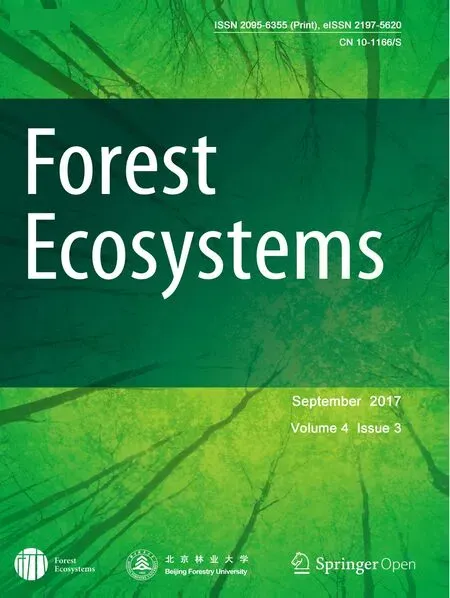Forest Ecosystems a SpringerOpen Journal
2017-04-05
Forest Ecosystems a SpringerOpen Journal
Aims and Scope
Forest Ecosystemsis an international Open Access journal publishing scientific communications from any discipline that can provide interesting contributions about the structure and dynamics of “natural” and “domesticated” forest ecosystems, and their services to people.We welcome innovative science as well as application oriented work that will enhance understanding of woody plant communities. Very specific studies are welcome if they are part of a thematic series that provides some holistic perspective that is of general interest.
Open access
All articles published byForest Ecosystemsare made freely and permanently accessible online immediately upon publication, without subscription charges or registration barriers.
Authors of articles published inForest Ecosystemsare the copyright holders of their articles and have granted to any third party, in advance and in perpetuity, the right to use, reproduce or disseminate the article, according to the SpringerOpen copyright and license agreement.
Article-processing charges
The publication costs forForest Ecosystemsare covered by Beijing Forestry University, so authors do not need to pay an article-processing charge.
Publication and peer review process
Authors will be able to check the progress of their manuscript through the submission system at any time by logging into Submit a manuscript, a personalized section of the site.
Portability of peer review
In order to support efficient and thorough peer review,we aim to reduce the number of times a manuscript is re-reviewed after rejection fromForest Ecosystems,thereby speeding up the publication process and reducing the burden on peer reviewers. Therefore, please note that, if a manuscript is not accepted for publication inForest Ecosystemsand the authors choose to submit a revised version to another SpringerOpen journal, we will pass the reviews on to the other journal's editors at the authors' request. We will reveal the reviewers' names to the handling editor for editorial purposes unless reviewers let us know when they return their report that they do not wish us to share their report with another SpringerOpen journal.
Editorial policies
Any manuscript, or substantial parts of it, submit t ed to the journal must not be under consideration by any other journal. In general, the manuscript should not have already been published in any journal or other citable form, although it may have been deposited on a preprint server. Authors are required to ensure that no material submit t ed as part of a manuscript infringes existing copyrights, or the rights of a third party.
Plagiarism detection
Forest Ecosystems's publisher, SpringerOpen, is a member of the CrossCheck plagiarism detection initiative. In cases of suspected plagiarism CrossCheck is available to the editors ofForest Ecosystemsto detect instances of overlapping and similar text in submitted manuscripts by using the plagiarism detection tool iThenticate. Cross-Check is a mult i-publisher initiative allowing screening of published and submit t ed content for originality.
Citing articles in Forest Ecosystems
Articles inForest Ecosystemsshould be cited in the same way as articles in a traditional journal. Because articles are not printed, they do not have page numbers; instead, they are given a unique article number.
Article citations follow this format:
Authors: Title.Forest Ecosystems[year] [volume number]:[article number].
e.g. Corral-Rivaset al.: Local and generalized heightdiameter models with random parameters for mixed,uneven-aged forests in Northwestern Durango, Mexico.Forest Ecosystems2014 1:6.
refers to article 6 from Volume 1 of the journal.
For details of how to prepare and submit a manuscript through the online submission system, please see the instructions for authors.
杂志排行
Forest Ecosystems的其它文章
- Development and evaluation of robust tree biomass equations for rubber tree(Hevea brasiliensis)plantations in India
- Climate change effects in the Western Himalayan ecosystems of India:evidence and strategies
- Dead standing pine trees in a boreal forest landscape in the Kalevala National Park,northern Fennoscandia:amount,population characteristics and spatial pattern
- Small mammal community response to early meadow–forest succession
- Stand dynamics of the drought-affected floodplain forests of Araguaia River,Brazilian Amazon
- Tree species diversity and utilities in a contracting lowland hillside rainforest fragment in Central Vietnam
